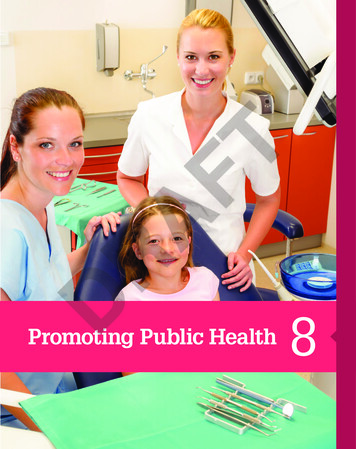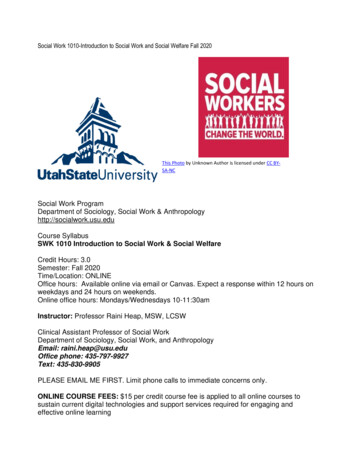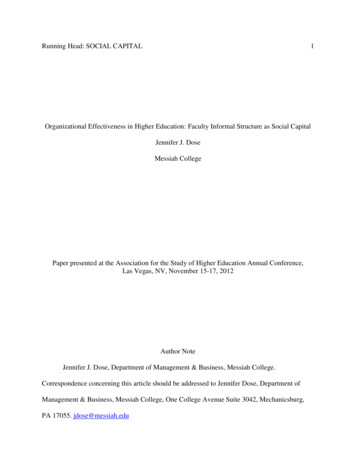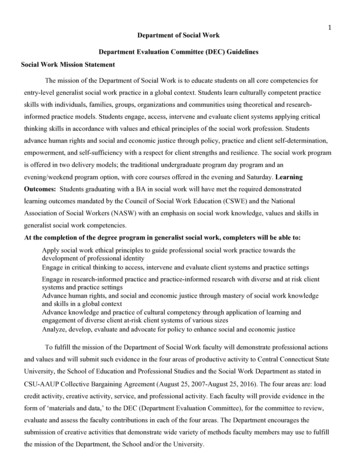
Transcription
FTARDPromoting Public Health8
UNIT 8Getting to know your unitThis unit will aim to help you understand the topic of how public healthis promoted throughout the world, but especially in the UK. Therewill be research topics given to you by your tutor to help you with thisunit and to assess your learning. Assignments will be set for eachlearning aim, with a pass, merit or distinction grade given. To obtain adistinction you must evaluate how far health strategies meet the aims ofhealth factors in Britain, or another area of your choice, which must beapproved by your tutor, and how successful a recent health strategy hasbeen.FTAssessm entYou will be assesse d by aseries of assignm ents setby your tutor.How you will be assessedYou will be assessed by a set of assignments set by your tutor, to ensure that you fullyunderstand the topic of how public health is promoted in the UK and worldwide.There will also be role plays given to you by your tutor to help you with this unit and toassess your learning.AAssignments will be set for each learning aim, with a pass, merit or distinction gradegiven.RIt is important to check that you have met all the Pass grading criteria as you workyour way through the assignments. To achieve a Merit or Distinction, you need topresent your work in such a way that you meet the criteria for those grades. To achieveMerit, you need to analyse and assess the impact of a recent health campaign; and forDistinction you need to evaluate and justify recent health campaigns.Assessment criteriaThis table shows what you must do in order to achieve a Pass, Merit or Distinction grade, and where youcan find activities to help you.DPassLearning aimADistinctionE xamine strategies for developing public health policy to improvethe health of individuals and the populationA.P1A.M1Explain the strategies used to developpublic health policy in order for it to meetits aims.Analyse how public health policy isinfluenced by strategies and patterns ofhealth and ill health.Assessment practice 8.1Assessment practice 8.1A.P2Explain how monitoring information todetermine patterns of health and ill healthis used by government to inform thecreation of public health policy.Assessment practice 8.1144MeritPromoting Public HealthA.D1Evaluate how far the use of strategiesand monitoring the health status of thepopulation helps public health policy tomeet its aims in reducing the factors thatinfluence public health, with reference to aspecific demographic area.Assessment practice 8.1
Getting to know your unitMeritLearning aimBDistinctionE xamine the factors affecting health and the impact of addressingthese factors to improve public healthB.P3B.M2Explain factors affecting current patternsof health and ill health in a specificdemographic area.Assess the extent to which factors affectcurrent patterns of health and ill health withreference to a specific demographic area.Assessment practice 8.1Assessment practice 8.1B.M3Explain the impact of public health policyin minimising these factors in relation to aspecific demographic area.Assessment practice 8.1Assess how minimising the factors affectinghealth can contribute to improving thehealth of the population in relation to thearea.FTB.P4Promoting Public HealthPassUNIT 8Assessment practice 8.1Learning aimCI nvestigate how health is promoted to improve the health of thepopulationC.P5C.M4Assess the success of approaches used topromote and protect health and preventdisease in a selected health promotioncampaign.Assessment practice 8.2Assessment practice 8.2C.P6Justify the approaches used to promoteand protect health and prevent disease in aselected health promotion campaign.Assessment practice 8.2AExplain how approaches to healthpromotion and protection have beenapplied in a selected health promotioncampaign.C.D2Explain how approaches to prevention andcontrol have been applied in a selectedcampaign.Assessment practice 8.2D.P7DI nvestigate how health promotion encourages individuals to changetheir behaviour in relation to their own healthRLearning aimD.M5Analyse how theories or models andapproaches have been used in a selectedhealth promotion campaign to overcomebarriers and increase public awareness.Assessment practice 8.2Assessment practice 8.2DExplain how models or theories that justifybehaviour change can be used to overcomebarriers in relation to a selected healthpromotion campaign.D.P8Explain the features of a selected healthpromotion campaign and the approachesused to increase public awareness.Assessment practice 8.2D.D3Evaluate the success of a specific publichealth campaign in encouraging behaviourchange in relation to health.Assessment practice 8.2D.D4Evaluate how far a recent health promotioncampaign met the aims of publichealth policy through the strategies andapproaches used to improve the health of ademographic area.Assessment practice 8.2145
Getting startedA good place to start is discussing, in groups, health campaigns beingpromoted on the television, radio or posters on health that you have seen orread. After the discussion you can note what you believe the campaign isabout and how effective it is.AExamine strategies for developing public health policyto improve the health of individuals and the populationFTThe origins and aims of public health policyOn 5 July 1948 the National Health Service came into being, to ensure that people inthe UK would receive free healthcare at the point of delivery, no matter what theirincome. It was the first health service of its kind in the world.ADuring and after the Second World War, the government and the major politicalparties became more aware and concerned about people’s health. Additionally, therewere considerations about recovery from serious injuries, some of which had neverbeen seen before, due to the bombing raids in the UK and from those incurred bythe people returning from fighting. Up until this time, people who could afford it hadprivate health insurance to help towards their medical bills. Those who could notafford to pay for a doctor and for medicine went without proper medical help.Key termRThe government commissioned Sir William Beveridge to investigate ways in which thecountry could recover from the Second World War. Beveridge had much experiencein political affairs and was an expert on the problem of unemployment. In 1942, theBeveridge Report (1942) was published. The report stated that the post-war period wasa time for radical change and one recommendation was that the government shouldfind ways to fight disease.DNotifiable disease – amedical condition required,by law, to be reported togovernment authorities.The public welcomed the Beveridge report. In 1940 measles became a notifiabledisease in England and Wales. There had been an epidemic of measles in 1940, whichwas a very serious illness at that time, with approximately 400,000 cases reported.Approximately one in twenty babies died before their first birthday, and every yearpeople died of infectious diseases such as pneumonia, meningitis, tuberculosis andpolio. There was overwhelming evidence for the need for health care for all.ResearchThere was another measles epidemic in 1961 in the UK, with 763,531 casesreported to Public Health England. Look at the statistics provided on: 2013 to find out what the major difference was between the epidemics in 1940and 1961. Why do you think this occurred?Between the First and Second World Wars, from 1919 to 1939, there had beennumerous reports on improving healthcare but nothing had been implemented.In 1945, the new Labour government took on the recommendations of the report and146Promoting Public Health
Learning aim AAFTPromoting Public Healththe National Health Service Act was passed in 1946, and came into force in 1948. TheNational Health Service (NHS) would be completely financed by tax, would benefitevery person in the country and be available from the cradle to the grave. For the firsttime, people could receive diagnosis and treatment of any illness, either at their homeor in hospital, including dental and ophthalmic care, regardless of their ability to pay.The implementation of a National Health Service has had a significant impact on thenation’s health, improving the health of millions.UNIT 8 Aneurin Bevan, the Minister for Health, visiting the first patients of the new NHS at TraffordGeneral Hospital in July 1948RAims of public health policyDPlanning national provision of health care and promoting the health of thepopulationThe government has an overriding moral aim to make sure that the health of itscitizens is paramount, and this became even more prevalent due to the health ofpeople during and after the Second World War. The NHS started to provide a moreaccessible health service to meet the aim of public health policy by ensuring fair andimpartial health services across the whole of the UK, so that an acceptable standardof good health would be experienced by the whole population regardless of socialstanding and geographical location.To meet the needs of a changing demographic, public health policy needs to beresponsive. To plan for future needs and to provide care in acute situations suchas the swine flu epidemic in 2009, the government needs to gather statistical dataand commission reports into current trends in health within the nation as well asattempting to predict future developments in the health status of the nation.Information on the factors that influence health such as lifestyle choices,unemployment, education, housing, prevalence of disease and poverty help to shapethe planning process for health provision. Public expectations of health provision andthe protection that it provides for their welfare have increased with technologicaladvances in medicine and equipment. Health trends have changed over the years,as more medical conditions become treatable and life expectancy has increased.147
Currently, public health policy has to address a range of issues such as dementia,mental health issues and rising rates of resistance to antimicrobial treatments as wellas raising awareness of the importance of healthy eating, exercising, moderation inalcohol consumption and stopping smoking.Case studyDebbie Does Her BestCheck your knowledge1 What health problems could the children develop byliving in this environment?FTWhen Debbie’s marriage to Tahir broke up and shelost her job at the biscuit factory she had to leave hercomfortable life behind and start again with two youngchildren. Accomodation was very expensive in the cityshe lived in and in order to move out of emergencyaccommodation provided by social services, Debbieborrowed money for the first month’s rent and a bondon a flat from her family.developed depression because of the break up of hermarriage and the state of her housing. She found itimpossible to find employment and she was upset thatshe couldn’t give the children a varied diet.Debbie’s flat was damp, black mould covered the wallsand condensation ran down the windows. The flat wasexpensive to heat and the children often slept withclothes on top of their pyjamas in the winter. Debbie2 How can unemployment have an impact on the shortterm and long term health of families?’3 Why is nutrition important to health?4 How can depression and unemployment affecthealth?DRAIdentifying and monitoring needsIt was noted by health officials that due to food rationing during the war and theten years after it, that people’s health improved. This was also investigated. Localauthorities at this time introduced Children’s and Mental Health Departments to helpsupport illness and conditions brought on by war, or poverty, and this became knownas the ‘social citizenship’ agenda, in which the government became the provider forthe welfare of all, for the first time. The World Health Organization (WHO) in 1946,identified health as a separate issue in which governments must be involved, to thebenefit of people’s physical, mental and social wellbeing, and not just for treatingdiseases. An active role in raising public awareness continued through the 1970sand 1980s with public information films on topics as varied as the safe handling offireworks and crossing the road safely, through to sexual health.The government’s role in understanding and predicting social change is pivotal inthe treatment and control of disease. As social influences such as the media and peerpressure become more prevalent, health policy needs to become more responsive.Examples of this include campaigns to raise awareness of the dangers of illegal druguse and the impact on the community of driving while under the influence of alcoholor drugs. The government response to medical evidence of the link between smokingand various types of cancer, including lung cancer and throat cancer, have led toa range of interventions controlling not just the advertising of cigarettes but alsorestictions on where individuals may smoke. Smoking in the workplace was banned inEngland on 1 July 2007.ResearchInvestigate the government’s response to the link between childhood obesity andtype 2 diabetes in children. What initiatives has the government tried to persuadeparents, carers and children to improve nutritional standards?148Promoting Public Health
Learning aim AFTProtecting society from health threatsFrom the 1970s onwards, factors such as crime rates, housing conditions, pollution,economic regeneration and education were observed as affecting the health andwellbeing of people. There are worldwide and national guidelines about monitoringthese issues and suggesting improvements to protect the population from thesehazards. For example, there is legislation about the disposal of toxic waste andstandards governing air quality in cities with regard to vehicle emissions.Promoting Public HealthIdentifying and reducing inequalitiesIt was not until 1974 that the NHS was responsible for the majority of public health.Prior to this, the NHS was being established, spreading across the nation andreclaiming responsibility for the health of all citizens. However, with the population’shealth needs differing enormously between rural and industrial areas, for example,establishing local authorities was found to have more of an impact on the provision ofappropriate health services.UNIT 8A new local authority role, Director of Health, required local authorities to be directlyresponsible for the health of their residents. All communicable illnesses are reportedthrough a GP, or local hospital, to a regional health team who monitor the overallincidence. If several cases of an infectious disease are reported, then an outbreakmanagement team investigates, monitoring its spread throughout the local area, andputting in place medical resources to prevent further spread.AWherever possible, preventative measures are used against infections that are likely tooccur on a seasonal basis. For example, flu vaccination is offered to vulnerable people,including the elderly, or those with a specific health condition such as diabetes, toprevent the illness in these groups. The immunisation of babies and infants to preventthe spread of communicable diseases such as mumps, measles and rubella, is anotherexample of a preventative measure.RControlling an outbreak of an infectious disease would include a case definitionreport. This includes information about the time, place, the person and the illness, sothat a picture can be established to understand where the outbreak started. The localhealth authorities use this information to report to the national health body, whichallows monitoring of whether the outbreak is spreading or decreasing, and appropriateresources to be implemented to prevent further spread.DAddressing national health problemsNational health problems are issues that can affect any sector of society, althoughthey may be more prevalent in some sectors than others, or some regions may findthemselves at higher risk than others. Air pollution, for example, affects everybodybut some areas have higher pollution than others. An example of this would be trafficpollution being higher in the cities. Further to this, some sectors of the communitymay be more affected by a problem than others. Someone with Chronic ObstructivePulmonary Disease (COPD) will suffer more breathing difficulties than the averageperson when air pollution levels are high.Poor diet and the build-up of fatty deposits in the arteries which break free and blockvessels in the brain is one cause of stroke.Developing screening programmesScreening is a way of identifying people who may be at a high risk of contractinga disease or condition, for example bowel or cervical cancer or glaucoma. If theindividual is found to have a health problem after the screening test, furtherinvestigation will be recommended. A screening programme has to be cost effectivefor the health service. There are more than 100 screening programmes in the UK.149
Screening programmes in the UK are targeted to sections of society that have alreadybeen identified as at a higher risk. A family history of breast cancer for example mayput a woman at higher risk of developing the disease.Certain age groups also have a higher prevalence of disorders. Cholestererol testingand blood pressure checks are routinely offered to people over 40 as the conditionsthat can come with having elevated levels of cholesterol or having high blood pressure,such as stroke, can strike without warning.P au s e p o intHintWhy did the NHS come into being?Think about how people afford and pay for health care.What was the immediate impact of the National Health Service Act 1946 on people’shealth at that time?FTExtendStrategies for developing public health policyStrategiesAThe Department of Health (DH) is the government department responsible foridentifying the nation’s health needs in England, and for developing programmes toreduce risk and screen for early signs of disease. The DH works with other agenciesto gain a full understanding of the issues around the nation’s health to create nationalpolicies and legislation. The agencies include: the Care Quality Commission (CQC) the Health and Social Care Information Centre NHS England Health Education England.DRPresent policies from the DH include: cancer research and treatment children’s health dementia drug misuse and dependency health and social care integration obesity and healthy eating.Each of these policy issues is broken down into further areas of concern. For example,‘School Food’ looks at caterers introducing healthier foods into school menus, andincludes research undertaken by Public Health England, Government Buying Standardsand the Children’s Food Trust.The Scottish Health and Social Care Directorate reports to the Secretary of Health onthe health and wellbeing of its citizens in 14 regional health authorities. The healthservices work with partners and the public to provide safe, effective and person-centredhealthcare. A recent strategy, part of the Quality Strategy, was ‘Better Health, BetterCare’, which proposed that NHS staff, patients, and carers should better understandtheir rights and responsibilities. This strategy aims to ensure compassionate staff, goodand clear communications, a safe environment and clinical excellence.In Northern Ireland, the Public Health Agency (PHA) works to increase wellbeingand to decrease inequalities in the health of its population. The PHA reports to theDepartment of Health (Northern Ireland). A recent strategy, ‘Making Life Better’,was created to help individuals have greater control of their own health, and to besupported by the health services in helping them achieve this.150Promoting Public Health
Learning aim APlanning and evaluatingThe DH undertakes research into all areas of the nation’s health. By using a range ofdifferent agencies throughout the UK, the DH obtains the right information for what toplan and put into place to help and support people with their health. The same agenciescan also feed back to the DH on any improvements needed in health care for their area.Promoting Public HealthThe NHS Wales strategy, ‘Together for Health’, aims to improve health services forthe benefit of the Welsh people. Another NHS Wales strategy, ‘Working differently –working together’, sets out how to improve health information for the future.UNIT 8FTAccording to the NHS Health Check Implementation Review and Action Plan 2013, theseven most preventable causes of death were alcohol consumption, high blood pressure,smoking, obesity, cholesterol, poor diet and lack of physical activity. By challenging thepublic’s acceptance of the inevitability of disease as being unrelated to lifestyle choices,the government can formulate strategies that help the public to help themselves.Obesity is another health issue that is affecting more people in England than in manyother developed countries. Public Health England reports that one in five childrenentering primary school is already overweight or obese. ‘Obesity and healthy living’ is thegovernment’s policy that aims to create a downward trend in the levels of excess weight inadults and children by 2020. This will be achieved through a series of a public awarenessdrives by the government that encourage people to eat a healthy diet and exercise more.AObesity is a particular issue in deprived areas. If the current trend continues, it ispredicted that 70 per cent of adults will be overweight or obese by the 2030s. Thefinancial costs to society associated with obesity-related diseases are increasing, suchas type 2 diabetes and coronary artery disease. Action to tackle obesity is one of PHE’sseven priorities. National mapping of weight management services (2015) was researchundertaken by PHE working with other, more local, agencies in an area of northernEngland to gather data on obesity.RMinimising harm from the environmentThe Department for Environment, Food & Rural Affairs (Defra) has responsibility forminimising harm to the population from environmental conditions that could causedisease.DPollutionA current concern is poor air quality, which is estimated to shorten life expectancyby about seven or eight months. Pollution from the density of road traffic in someLondon streets surpasses the annual European air pollution targets within days.Defra works with Environmental Protection UK to implement The Air Quality Strategyfor England, Scotland, Wales and Northern Ireland. The strategy aims to minimiselevels of harmful industrial pollutants in the air such as lead, sulfur dioxide andnitrogen oxide; levels for their output are set and checked nationally, as are emissionsfrom industry and sea pollution.Recycling and waste managementFor issues around recycling and waste management, the government works closelywith the Environment Agency, who in turn works with local agencies concernedwith waste and recycling. This is to ensure that waste management companies areregulated and monitored by local authorities issuing permits to companies applyingto recycle and dispose of waste. The waste is categorised (for example hazardouschemicals, metal, medicines, batteries or paper) with regulations for all types of waste.One such regulation is the Waste Electrical and Electronic Equipment (WEEE) guidance151
for approved authorised treatment facilities and approved exporters, which wasupdated in January 2016. The guidelines set targets for the recycling of items such assmall and large household appliances, IT and telecommunications equipment, lightingequipment, electrical and electronic tools, toys, leisure and sports equipment, medicaldevices (except implanted/infected products), display screens and photovoltaic panels.Case studyA Little Won’t MatterWhen Kristof was young he had a transistor radio and itused up batteries quickly and batteries were expensiveso he didn’t use the radio very often. When the batterieswore out he threw them in the bin.Check your knowledge1 What problems could the batteries cause to theenvironment if not disposed of safely?FTForty years later, Kristof has, among other things: amobile phone, an electric toothbrush, a torch, anelectric car key, an electric cigarette, a cordless doorbell, a smoke detector, a laptop and a small clock inevery room to help him organise his life.seen the point of going to the council tip as the dustbinmen come every week and empty his bin. He never usesthe council recycling services.Kristof likes new things so he updates his appliances asoften as he can afford to. The things that Kristof doesn’tneed and can’t sell he throws away. Kristof has never2 How can Kristof reduce the amount of damage thathe causes to the environment by using his electricalequipment?’3 Why is it important for public health that peopleare aware of environmental issues such as the safedisposal of toxic materials?AThere are many other everyday items that can cause ill health if they are not disposed ofcorrectly. All drugs including prescription medications, over-the-counter medications andillegal drugs have the potential to cause harm to public health if they are not disposedof appropriately. Medication should be returned to the pharmacist for safe disposal, notflushed down the toilet where it can enter the water course and cause contamination.DRMany other products such as engine oil, paint, baby wipes and even the fat fromcooking have the potential to contaminate the water course or damage the sewagesystem. Blocked waste pipes or sewage pipes can force sewage to back up intopeople’s homes, flooding them with faecal matter which, if ingested, exposes theresidents to a potential range of bacterial illnesses of the digestive system.Key termGenetically modified –altering the DNA of anorganism (food or plant) tocreate something that doesnot occur through naturalreproduction.Food safetyThe Food Standards Agency (FSA) is a non-ministerial government departmentresponsible for food safety and hygiene throughout the UK. The FSA works with sevenother agencies and local authorities to enforce food safety regulations. The Welshgovernment is responsible for nutrition policy in Wales.The Advisory Committee on Novel Foods and Processes advises the FSA aboutgenetically modified foods and irradiation of foods. Genetically modified cropsand irradiation of foodstuffs are considered by scientists working in the field not tobe riskier to human health than conventional food. However, the general public hasfrequently expressed concerns about their safety and regulation, including labellingand environmental impacts.ResearchInvestigate the government’s current health campaign: Sugar Smart 2016.Create information for a display board for staff and other learners at your schoolor college. What do you think this campaign hopes to achieve?152Promoting Public Health
Learning aim AHintThink about all the different things that can affect people’s health.Research a government policy on children’s health. Find out which agencies thegovernment works with to get information.ExtendMonitoring the health status of the populationPromoting Public HealthWhy does the government work with a range of agencies with regard to people’shealth?P au s e p o intUNIT 8Health monitoring is an important way of maintaining the nation’s health. By closelymonitoring outbreaks of diseases, or the increase of the incidence of illnesses seriouslydangerous to health, local, regional and governmental departments are able to put inplace the necessary resources.FTSources of information for determining patterns of health and illhealthSources are wide and varied. The DH website reflects the many agencies that report togovernment about health-related issues.2,538 people in 2013 diedfrom mesothelioma (due topast exposure to asbestos)Health andsafety statistics 14.3 billion was theestimated cost ofinjuries and ill healthin 2013/14 from currentworking conditionsR76,000 injuries toemployees arereported underRIDDOR142 workers werekilled at workA1.2 million workingpeople have awork-related illness611,000 injuriesoccur at work27.3 million working days are lost due towork-related illness and workplace injuryD Figure 8.1: Key health and safety statistics, Great Britain (2014/15) (source: www.hse.gov.uk/statistics)Where do you think the information in Figure 8.1, as reported to the Health andSafety Executive (HSE) comes from? There are several data sources for injury and illhealth statistics in Britain, some of which were mentioned in relation to the work ofthe DH (see the section on Strategies for developing public health policy). The HSE isa government agency, reporting directly to the government, which is used to reportinjuries, illnesses and diseases related to work. It obtains its data from the agencieswith which it works. It is a legal requirement to report incidents and ill health at workto enable the HSE, and other agencies, to gather data about how and why risks arise,and to investigate serious incidents with a view to their prevention.RIDDORReporting of Injuries, Diseases and Dangerous Occurrences Regulations (RIDDOR),covers the reporting by employers of any diseases or illnesses affecting their workersthat are potentially caused by the work environment. This is useful in determiningthe healthcare needs that occur in certain occupations. The data can also be used to153
see whether any further precautions are required for certain tasks. Employers maythink any incidents are isolated, whereas by reporting it to the HSE, it may be shownto occur frequently in certain occupations. The information can be used to supportworkers’ health and to put safe working practices in place.The Labour Force Survey (LFS)The LFS surveys more than 40,000 households in Britain to determine whetheroccupants have work-related illnesses. Again, this information is fed back to the HSEfo
country could recover from the Second World War. Beveridge had much experience in political affairs and was an expert on the problem of unemployment. In 1942, the Beveridge Report (1942) was published. The report stated that the post-war period was a time for radical cha










